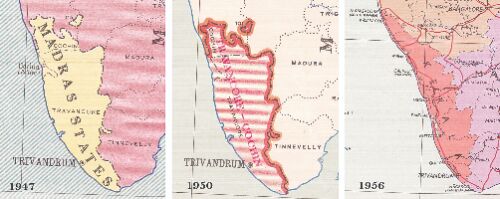Formation of Kerala — I
Changing circumstances and sentiments post-independence enabled the creation of the Union of Travancore-Cochin

When Gopalkrishna Gandhi, the grandson to both Mahatma Gandhi and C Rajagopalachari, and a former Governor of West Bengal was asked to speak on 'Kerala and Gandhi', his first comment was "There is a definitional flaw in the title Kerala and Gandhi, for Kerala as we know it (now) did not exist in the Mahatma's time. We had the states of Travancore and Cochin, and we had Malabar".
Malabar was the Malayalee speaking part of the Madras Presidency, renamed Madras State after Independence. Together these were the three units which the Aikya Kerala movement pressed for as a single entity in the memorandum submitted to the States Reorganisation Commission. However, the sentiment was not uncontested, for there was a considerable body of opinion which preferred amalgamation with Madras. In fact, three sets of options, including a Dakshin Pradesh with the four linguistic zones of Tamil, Telugu, Kannada and Malayalam were on the table. While Mysore and Andhra had their own linguistic states, given the Malabar connection with Madras, the merger of Travancore — Cochin and Madras was a distinct possibility, and it appears that the Planning Commission and the Governor of Madras were in serious correspondence on this subject.
Thus VT Krishnamachari, Deputy Chairman of the Planning Commission wrote to Prakasa, the Governor of Madras in November 1955: 'I wonder if it is too late to work for a combined Madras and Kerala. I am not concerned with the political aspects: but from the economic point of view, such a combined state would be of utmost benefit to both the areas. Krishnamachari also wrote to the Home Minister. BG Pant 'proposals for a merger or other forms of collaboration between states throw up interesting possibilities of development which are worth exploring. As a case study, some aspects of proposals relating to Madras and Travancore–Cochin have been recently examined in the Planning Commission.' The Home Minister was of course, more reticent, for he said 'unless adequate popular support is forthcoming, I doubt if anything will be achieved at this stage'.
However, in the aftermath of Independence, the States Ministry was quite keen to merge the two princely states of Travancore and Cochin into one Union. While the people of both Travancore and Cochin were of the same stock, and spoke the same language and shared the same cultural connect, there were differences for Cochin had been a 'progressive state', while Travancore was more conservative and change-resistant. Cochin had an effective Legislative Council with an elected majority from 1925 and was the first state to send its representative to the constituent Assembly, as well as amongst the first to accede to the Indian Dominion. Travancore had been literally nudged into accession.
Travancore was also the site of the famous Vaikom Satyagraha of 1924 on the issue of freedom of movement on the roads leading to the opening of the famous Shiva temple at Vaikom. Not only did the Satyagraha receive support from all sections of society in the state, but an Akali delegation from Punjab also joined the protest movement. The Mahatma too lent his fullest support to the movement and stated 'in this age of reason, in this age of universal knowledge, this age of education and comparative theology ... untouchability is a blot upon humanity and therefore upon Hinduism. It cannot stand the test of reason'. After an agitation lasting 21 months, all public roads and streets were thrown open to all Hindus, irrespective of caste, and the Mahatma called it the bedrock of freedom'. However, it was not until the famous Temple Entry proclamation of November 12, 1936, that all the Kshetrams (temple spaces) were opened to all Hindus. This action of the last ruling king of Travancore, Chithira Thirunal Balaram Varma won his accolades from across the country, most notably from the Mahatma. However his Prime Minister, Sir CP Ramaswami Iyer was quite unpopular, more so with the growing number of Communist supporters in the state. Congressmen were also upset with him for, in July 1947, he issued a statement seeking Independence for Travancore, and showing extreme reluctance to join the Indian Union. However, he was eased out as the Dewan, and negotiations were opened on the future of the state with the new Prime Minister PGN Unnithan who assisted the Maharaja Sree Chithira Thirunal.
VP Menon was accorded the honour of inaugurating the new state of Travancore–Cochin on July 1, 1949, with an area of 9,155 square miles and population of 75 lakhs and an income of 13.5 crores. The Maharaja of Travancore was also appointed the first Rajpramukh of the new state, and even though the Maharaja of Cochin was asked to be the Uparaja Pramukh of the new state, he politely declined the offer but requested that the eldest member of the Royal Family be designated 'Valiya Thampuram'.
Postscript
While researching the history of Kerala, more specifically the rivalry between Cochin and Calicut on the Malabar Coast, the role of the Ming dynasty of China comes to the fore. Cochin and its ruler were given a special status and the title of Keyli in 1411 CE. Although Calicut was the dominant port city, Cochin had emerged as a rival, and the Chinese Admiral Zheng He delivered a stone tablet inscribed by the Emperor himself. As long as the Ming Treasure voyages continued, Cochin had an upper hand over
Calicut, but when these stopped, the Zamorin of Calicut occupied Cochin and installed his representative as the King. Thus the kingdom of Cochin is the only known protectorate of China in South Asia.
The writer is the Director of LBSNAA and Honorary Curator, Valley of Words: Literature and Arts Festival, Dehradun
Views expressed are personal



